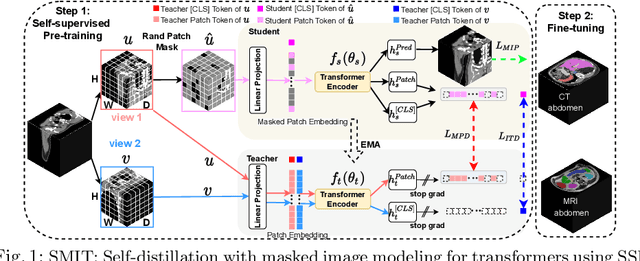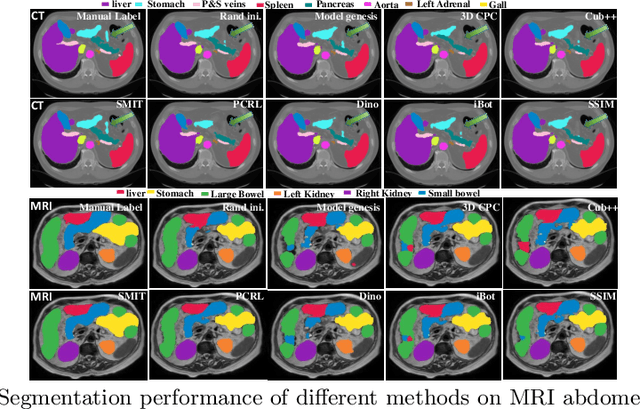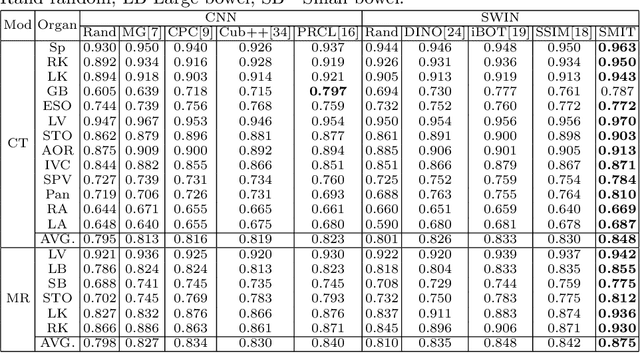Jue Jiang
Segmentation Regularized Training for Multi-Domain Deep Learning Registration applied to MR-Guided Prostate Cancer Radiotherapy
Jul 09, 2025Abstract:Background: Accurate deformable image registration (DIR) is required for contour propagation and dose accumulation in MR-guided adaptive radiotherapy (MRgART). This study trained and evaluated a deep learning DIR method for domain invariant MR-MR registration. Methods: A progressively refined registration and segmentation (ProRSeg) method was trained with 262 pairs of 3T MR simulation scans from prostate cancer patients using weighted segmentation consistency loss. ProRSeg was tested on same- (58 pairs), cross- (72 1.5T MR Linac pairs), and mixed-domain (42 MRSim-MRL pairs) datasets for contour propagation accuracy of clinical target volume (CTV), bladder, and rectum. Dose accumulation was performed for 42 patients undergoing 5-fraction MRgART. Results: ProRSeg demonstrated generalization for bladder with similar Dice Similarity Coefficients across domains (0.88, 0.87, 0.86). For rectum and CTV, performance was domain-dependent with higher accuracy on cross-domain MRL dataset (DSCs 0.89) versus same-domain data. The model's strong cross-domain performance prompted us to study the feasibility of using it for dose accumulation. Dose accumulation showed 83.3% of patients met CTV coverage (D95 >= 40.0 Gy) and bladder sparing (D50 <= 20.0 Gy) constraints. All patients achieved minimum mean target dose (>40.4 Gy), but only 9.5% remained under upper limit (<42.0 Gy). Conclusions: ProRSeg showed reasonable multi-domain MR-MR registration performance for prostate cancer patients with preliminary feasibility for evaluating treatment compliance to clinical constraints.
Modality-agnostic, patient-specific digital twins modeling temporally varying digestive motion
Jul 03, 2025Abstract:Objective: Clinical implementation of deformable image registration (DIR) requires voxel-based spatial accuracy metrics such as manually identified landmarks, which are challenging to implement for highly mobile gastrointestinal (GI) organs. To address this, patient-specific digital twins (DT) modeling temporally varying motion were created to assess the accuracy of DIR methods. Approach: 21 motion phases simulating digestive GI motion as 4D sequences were generated from static 3D patient scans using published analytical GI motion models through a semi-automated pipeline. Eleven datasets, including six T2w FSE MRI (T2w MRI), two T1w 4D golden-angle stack-of-stars, and three contrast-enhanced CT scans. The motion amplitudes of the DTs were assessed against real patient stomach motion amplitudes extracted from independent 4D MRI datasets. The generated DTs were then used to assess six different DIR methods using target registration error, Dice similarity coefficient, and the 95th percentile Hausdorff distance using summary metrics and voxel-level granular visualizations. Finally, for a subset of T2w MRI scans from patients treated with MR-guided radiation therapy, dose distributions were warped and accumulated to assess dose warping errors, including evaluations of DIR performance in both low- and high-dose regions for patient-specific error estimation. Main results: Our proposed pipeline synthesized DTs modeling realistic GI motion, achieving mean and maximum motion amplitudes and a mean log Jacobian determinant within 0.8 mm and 0.01, respectively, similar to published real-patient gastric motion data. It also enables the extraction of detailed quantitative DIR performance metrics and rigorous validation of dose mapping accuracy. Significance: The pipeline enables rigorously testing DIR tools for dynamic, anatomically complex regions enabling granular spatial and dosimetric accuracies.
Tumor aware recurrent inter-patient deformable image registration of computed tomography scans with lung cancer
Sep 18, 2024Abstract:Background: Voxel-based analysis (VBA) for population level radiotherapy (RT) outcomes modeling requires topology preserving inter-patient deformable image registration (DIR) that preserves tumors on moving images while avoiding unrealistic deformations due to tumors occurring on fixed images. Purpose: We developed a tumor-aware recurrent registration (TRACER) deep learning (DL) method and evaluated its suitability for VBA. Methods: TRACER consists of encoder layers implemented with stacked 3D convolutional long short term memory network (3D-CLSTM) followed by decoder and spatial transform layers to compute dense deformation vector field (DVF). Multiple CLSTM steps are used to compute a progressive sequence of deformations. Input conditioning was applied by including tumor segmentations with 3D image pairs as input channels. Bidirectional tumor rigidity, image similarity, and deformation smoothness losses were used to optimize the network in an unsupervised manner. TRACER and multiple DL methods were trained with 204 3D CT image pairs from patients with lung cancers (LC) and evaluated using (a) Dataset I (N = 308 pairs) with DL segmented LCs, (b) Dataset II (N = 765 pairs) with manually delineated LCs, and (c) Dataset III with 42 LC patients treated with RT. Results: TRACER accurately aligned normal tissues. It best preserved tumors, blackindicated by the smallest tumor volume difference of 0.24\%, 0.40\%, and 0.13 \% and mean square error in CT intensities of 0.005, 0.005, 0.004, computed between original and resampled moving image tumors, for Datasets I, II, and III, respectively. It resulted in the smallest planned RT tumor dose difference computed between original and resampled moving images of 0.01 Gy and 0.013 Gy when using a female and a male reference.
Self-supervised learning improves robustness of deep learning lung tumor segmentation to CT imaging differences
May 14, 2024



Abstract:Self-supervised learning (SSL) is an approach to extract useful feature representations from unlabeled data, and enable fine-tuning on downstream tasks with limited labeled examples. Self-pretraining is a SSL approach that uses the curated task dataset for both pretraining the networks and fine-tuning them. Availability of large, diverse, and uncurated public medical image sets provides the opportunity to apply SSL in the "wild" and potentially extract features robust to imaging variations. However, the benefit of wild- vs self-pretraining has not been studied for medical image analysis. In this paper, we compare robustness of wild versus self-pretrained transformer (vision transformer [ViT] and hierarchical shifted window [Swin]) models to computed tomography (CT) imaging differences for non-small cell lung cancer (NSCLC) segmentation. Wild-pretrained Swin models outperformed self-pretrained Swin for the various imaging acquisitions. ViT resulted in similar accuracy for both wild- and self-pretrained models. Masked image prediction pretext task that forces networks to learn the local structure resulted in higher accuracy compared to contrastive task that models global image information. Wild-pretrained models resulted in higher feature reuse at the lower level layers and feature differentiation close to output layer after fine-tuning. Hence, we conclude: Wild-pretrained networks were more robust to analyzed CT imaging differences for lung tumor segmentation than self-pretrained methods. Swin architecture benefited from such pretraining more than ViT.
Safeguarding Medical Image Segmentation Datasets against Unauthorized Training via Contour- and Texture-Aware Perturbations
Mar 21, 2024Abstract:The widespread availability of publicly accessible medical images has significantly propelled advancements in various research and clinical fields. Nonetheless, concerns regarding unauthorized training of AI systems for commercial purposes and the duties of patient privacy protection have led numerous institutions to hesitate to share their images. This is particularly true for medical image segmentation (MIS) datasets, where the processes of collection and fine-grained annotation are time-intensive and laborious. Recently, Unlearnable Examples (UEs) methods have shown the potential to protect images by adding invisible shortcuts. These shortcuts can prevent unauthorized deep neural networks from generalizing. However, existing UEs are designed for natural image classification and fail to protect MIS datasets imperceptibly as their protective perturbations are less learnable than important prior knowledge in MIS, e.g., contour and texture features. To this end, we propose an Unlearnable Medical image generation method, termed UMed. UMed integrates the prior knowledge of MIS by injecting contour- and texture-aware perturbations to protect images. Given that our target is to only poison features critical to MIS, UMed requires only minimal perturbations within the ROI and its contour to achieve greater imperceptibility (average PSNR is 50.03) and protective performance (clean average DSC degrades from 82.18% to 6.80%).
Trustworthiness of Pretrained Transformers for Lung Cancer Segmentation
Mar 19, 2024Abstract:We assessed the trustworthiness of two self-supervision pretrained transformer models, Swin UNETR and SMIT, for fine-tuned lung (LC) tumor segmentation using 670 CT and MRI scans. We measured segmentation accuracy on two public 3D-CT datasets, robustness on CT scans of patients with COVID-19, CT scans of patients with ovarian cancer and T2-weighted MRI of men with prostate cancer, and zero-shot generalization of LC for T2-weighted MRIs. Both models demonstrated high accuracy on in-distribution data (Dice 0.80 for SMIT and 0.78 for Swin UNETR). SMIT showed similar near-out-of-distribution performance on CT scans (AUROC 89.85% vs. 89.19%) but significantly better far-out-of-distribution accuracy on CT (AUROC 97.2% vs. 87.1%) and MRI (92.15% vs. 73.8%). SMIT outperformed Swin UNETR in zero-shot segmentation on MRI (Dice 0.78 vs. 0.69). We expect these findings to guide the safe development and deployment of current and future pretrained models in routine clinical use.
Self-distilled Masked Attention guided masked image modeling with noise Regularized Teacher (SMART) for medical image analysis
Oct 02, 2023



Abstract:Hierarchical shifted window transformers (Swin) are a computationally efficient and more accurate alternative to plain vision transformers. Masked image modeling (MIM)-based pretraining is highly effective in increasing models' transferability to a variety of downstream tasks. However, more accurate and efficient attention guided MIM approaches are difficult to implement with Swin due to it's lack of an explicit global attention. We thus architecturally enhanced Swin with semantic class attention for self-supervised attention guided co-distillation with MIM. We also introduced a noise injected momentum teacher, implemented with patch dropout of teacher's inputs for improved training regularization and accuracy. Our approach, called \underline{s}elf-distilled \underline{m}asked \underline{a}ttention MIM with noise \underline{r}egularized \underline{t}eacher (SMART) was pretrained with \textbf{10,412} unlabeled 3D computed tomography (CT)s of multiple disease sites and sourced from institutional and public datasets. We evaluated SMART for multiple downstream tasks involving analysis of 3D CTs of lung cancer (LC) patients for: (i) [Task I] predicting immunotherapy response in advanced stage LC (n = 200 internal dataset), (ii) [Task II] predicting LC recurrence in early stage LC before surgery (n = 156 public dataset), (iii) [Task III] LC segmentation (n = 200 internal, 21 public dataset), and (iv) [Task IV] unsupervised clustering of organs in the chest and abdomen (n = 1,743 public dataset) \underline{without} finetuning. SMART predicted immunotherapy response with an AUC of 0.916, LC recurrence with an AUC of 0.793, segmented LC with Dice accuracy of 0.81, and clustered organs with an inter-class cluster distance of 5.94, indicating capability of attention guided MIM for Swin in medical image analysis.
Deep Learning Based Dominant Index Lesion Segmentation for MR-guided Radiation Therapy of Prostate Cancer
Mar 06, 2023Abstract:Dose escalation radiotherapy allows increased control of prostate cancer (PCa) but requires segmentation of dominant index lesions (DIL), motivating the development of automated methods for fast, accurate, and consistent segmentation of PCa DIL. We evaluated five deep-learning networks on apparent diffusion coefficient (ADC) MRI from 500 lesions in 365 patients arising from internal training Dataset 1 (1.5Tesla GE MR with endorectal coil), external ProstateX Dataset 2 (3Tesla Siemens MR), and internal inter-rater Dataset 3 (3Tesla Philips MR). The networks include: multiple resolution residually connected network (MRRN) and MRRN regularized in training with deep supervision (MRRN-DS), Unet, Unet++, ResUnet, and fast panoptic segmentation (FPSnet) as well as fast panoptic segmentation with smoothed labels (FPSnet-SL). Models were evaluated by volumetric DIL segmentation accuracy using Dice similarity coefficient (DSC) and detection accuracy, as a function of lesion aggressiveness, size, and location (Dataset 1 and 2), and accuracy with respect to two-raters (on Dataset 3). In general MRRN-DS more accurately segmented tumors than other methods on the testing datasets. MRRN-DS significantly outperformed ResUnet in Dataset2 (DSC of 0.54 vs. 0.44, p<0.001) and the Unet++ in Dataset3 (DSC of 0.45 vs. p=0.04). FPSnet-SL was similarly accurate as MRRN-DS in Dataset2 (p = 0.30), but MRRN-DS significantly outperformed FPSnet and FPSnet-SL in both Dataset1 (0.60 vs 0.51 [p=0.01] and 0.54 [p=0.049] respectively) and Dataset3 (0.45 vs 0.06 [p=0.002] and 0.24 [p=0.004] respectively). Finally, MRRN-DS produced slightly higher agreement with experienced radiologist than two radiologists in Dataset 3 (DSC of 0.45 vs. 0.41).
* https://pubmed.ncbi.nlm.nih.gov/36856092/
Progressively refined deep joint registration segmentation (ProRSeg) of gastrointestinal organs at risk: Application to MRI and cone-beam CT
Oct 25, 2022



Abstract:Method: ProRSeg was trained using 5-fold cross-validation with 110 T2-weighted MRI acquired at 5 treatment fractions from 10 different patients, taking care that same patient scans were not placed in training and testing folds. Segmentation accuracy was measured using Dice similarity coefficient (DSC) and Hausdorff distance at 95th percentile (HD95). Registration consistency was measured using coefficient of variation (CV) in displacement of OARs. Ablation tests and accuracy comparisons against multiple methods were done. Finally, applicability of ProRSeg to segment cone-beam CT (CBCT) scans was evaluated on 80 scans using 5-fold cross-validation. Results: ProRSeg processed 3D volumes (128 $\times$ 192 $\times$ 128) in 3 secs on a NVIDIA Tesla V100 GPU. It's segmentations were significantly more accurate ($p<0.001$) than compared methods, achieving a DSC of 0.94 $\pm$0.02 for liver, 0.88$\pm$0.04 for large bowel, 0.78$\pm$0.03 for small bowel and 0.82$\pm$0.04 for stomach-duodenum from MRI. ProRSeg achieved a DSC of 0.72$\pm$0.01 for small bowel and 0.76$\pm$0.03 for stomach-duodenum from CBCT. ProRSeg registrations resulted in the lowest CV in displacement (stomach-duodenum $CV_{x}$: 0.75\%, $CV_{y}$: 0.73\%, and $CV_{z}$: 0.81\%; small bowel $CV_{x}$: 0.80\%, $CV_{y}$: 0.80\%, and $CV_{z}$: 0.68\%; large bowel $CV_{x}$: 0.71\%, $CV_{y}$ : 0.81\%, and $CV_{z}$: 0.75\%). ProRSeg based dose accumulation accounting for intra-fraction (pre-treatment to post-treatment MRI scan) and inter-fraction motion showed that the organ dose constraints were violated in 4 patients for stomach-duodenum and for 3 patients for small bowel. Study limitations include lack of independent testing and ground truth phantom datasets to measure dose accumulation accuracy.
Self-supervised 3D anatomy segmentation using self-distilled masked image transformer (SMIT)
May 20, 2022



Abstract:Vision transformers, with their ability to more efficiently model long-range context, have demonstrated impressive accuracy gains in several computer vision and medical image analysis tasks including segmentation. However, such methods need large labeled datasets for training, which is hard to obtain for medical image analysis. Self-supervised learning (SSL) has demonstrated success in medical image segmentation using convolutional networks. In this work, we developed a \underline{s}elf-distillation learning with \underline{m}asked \underline{i}mage modeling method to perform SSL for vision \underline{t}ransformers (SMIT) applied to 3D multi-organ segmentation from CT and MRI. Our contribution is a dense pixel-wise regression within masked patches called masked image prediction, which we combined with masked patch token distillation as pretext task to pre-train vision transformers. We show our approach is more accurate and requires fewer fine tuning datasets than other pretext tasks. Unlike prior medical image methods, which typically used image sets arising from disease sites and imaging modalities corresponding to the target tasks, we used 3,643 CT scans (602,708 images) arising from head and neck, lung, and kidney cancers as well as COVID-19 for pre-training and applied it to abdominal organs segmentation from MRI pancreatic cancer patients as well as publicly available 13 different abdominal organs segmentation from CT. Our method showed clear accuracy improvement (average DSC of 0.875 from MRI and 0.878 from CT) with reduced requirement for fine-tuning datasets over commonly used pretext tasks. Extensive comparisons against multiple current SSL methods were done. Code will be made available upon acceptance for publication.
 Add to Chrome
Add to Chrome Add to Firefox
Add to Firefox Add to Edge
Add to Edge